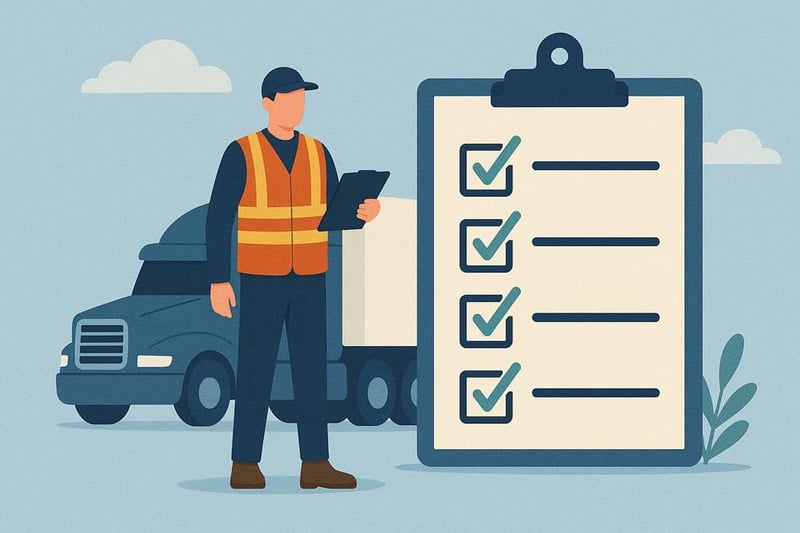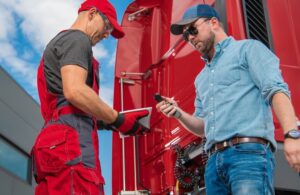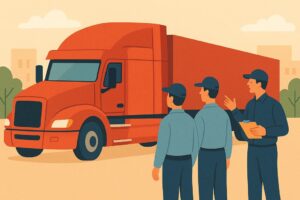Everything Your New CDL Hire Needs to Succeed
This guide is designed for fleet supervisors, safety managers, and HR personnel who oversee commercial driver hiring or training under Federal Motor Carrier Safety Administration (FMCSA) regulations.
Background
New commercial driver onboarding involves mandatory compliance with federal regulations, particularly Entry-Level Driver Training (ELDT) requirements. A CDL new hire checklist helps streamline this process and speeds up the CDL permit-to-license process, with a goal of providing oversight as it relates to necessary regulations.
What to Include in Your CDL Onboarding Process
- Obtain a Commercial Learner’s Permit
Before a new driver can train in a commercial motor vehicle (CMV) on public roads, they must obtain a Commercial Learner’s Permit (CLP). This process begins with passing a Department of Transportation (DOT) medical exam and drug screening to meet federal safety and health standards. Once this is done, individuals must register with their state’s licensing agency and pass the written general knowledge test, which covers general commercial driving rules, vehicle inspections, safe operating techniques, basic air brake systems, and more (FMCSA, 2023). Each candidate must do the following:
- Pass the DOT medical exam and drug screen.
- Register with the state driver licensing agency (SDLA) for the written knowledge test.
- Obtain a CLP after passing written exams for general knowledge and (where applicable) combination vehicles, air brakes, and endorsements.
- Complete Entry-Level Driver Training (ELDT)
As of February 7, 2022, all new CDL applicants have been required to complete ELDT from an FMCSA-registered provider. This training consists of both theory instruction and behind-the-wheel (BTW) driving practice, covering topics like vehicle control, hours-of-service rules, and safety procedures. The training program must be compliant with ELDT requirements, and successful training completion must be recorded in the FMCSA Training Provider Registry (TPR) before the driver may take the CDL skills test (FMCSA, 2022).
- Enroll drivers in an FMCSA-approved ELDT program (theory and behind-the-wheel).
- Verify completion through FMCSA’s TPR before drivers may take the skills test.
- Schedule CDL Skills Test
A driver who has obtained a CLP and held it for a minimum of 14 days is eligible to take the CDL skills test. This state-administered exam includes a pre-trip inspection, basic vehicle control maneuvers, and a road test. The driver must take the test in a vehicle that matches the class and type of the CDL being sought (FMCSA, 2023).
After holding the CLP for at least 14 days, arrange the pre-trip, maneuvers, and road skills test.
Confirm the vehicle used for testing matches the class of the desired CDL classification.
- CDL Issuance and Document Collection
After a driver passes the skills test, the SDLA will issue a CDL to the driver. Employers should then collect a copy of the CDL and proof of ELDT completion. (Effective June 23, 2025, the driver’s medical examiner will electronically submit the results of the medical exam directly to FMCSA and the SDLA. Until then, the employer will be responsible for collecting the driver’s medical card for submission.) Also, per FMCSA regulations, employers should conduct Motor Vehicle Record (MVR) checks and safety performance history inquiries to complete the driver qualification file (FMCSA, 2022).
- Collect copies of the issued CDL and ELDT completion certificate.
- Begin MVR checks and background verifications.
- Comply with FMCSA Drug and Alcohol Requirements
Employers must now meet all FMCSA drug and alcohol compliance standards, which include conducting a pre-employment inquiry with the Drug & Alcohol Clearinghouse to check for violations. Additionally, employers must issue a DOT-approved drug test to the applicant. The results must be confirmed negative before hiring. By federal mandate, once the applicant is hired, the new driver must be enrolled in a random testing program to maintain compliance (FMCSA, 2023).
- Conduct a pre-employment Clearinghouse inquiry.
- Administer a pre-employment drug test with a verified negative result.
- Add the new driver to a random testing pool.
- Fleet Driver Orientation
A structured orientation helps ensure that newly licensed CDL drivers are in compliance and have the knowledge and skills needed to operate commercial vehicles safely. This phase should include training in hours-of-service (HOS) rules, electronic logging device (ELD) usage, and company safety policies. Drivers must also be taught how to conduct vehicle inspections and proper reporting procedures (FMCSA, 2021).
- Provide safety training, hours-of-service (HOS) instruction, and ELD training.
- Include policy reviews and vehicle inspection procedures.
- Post-License Supervision and Check-Ins
After licensing, it is advisable to provide each new driver with a mentor or safety trainer to guide them through their first runs. Scheduled check-ins should occur at 30, 60, and 90 days to monitor performance, address initial driving concerns, and ensure compliance.
- Pair new drivers with a mentor or safety trainer for initial runs.
- Perform check-ins at 30, 60, and 90 days to monitor progress and ensure compliance.
Key Takeaways
- A standardized fleet driver training checklist helps ensure compliance and reduces risk.
- Using the FMCSA TPR simplifies tracking and eases documentation.
- Combining supervised practice with ELDT completion is ideal for achieving road readiness.
How Driving-Tests.org Can Help You
A new driver checklist is invaluable for companies. It streamlines the onboarding process, helps prevent administrative oversight, and speeds the CDL permit-to-license process. Incorporating Driving-Tests.org’s CDL Premium Corporate platform into your program is advantageous to learners and especially helpful in creating a well-rounded approach for your employees. It also provides these advantageous features:
- Comprehensive CDL Test Preparation: Access to up-to-date practice tests and study materials aligned with FMCSA guidelines.
- Progress Tracking and Reporting: Easily track each driver’s progress and test results to streamline record-keeping.
- Multi-User Management: Add and remove drivers or training coordinators quickly; keep everyone accountable with assigned modules.
- Engaging Mobile-Friendly Content: Drivers can study on their own schedule, reducing classroom time and improving pass rates.
By integrating proven online learning tools with practical test preparation, your drivers will be well-equipped to pass their official knowledge tests in either an in-house or third-party school setting. The included checklist should prove valuable as you work through the overall process.
References
Federal Motor Carrier Safety Administration (FMCSA). (2019, July 22). When must current and prospective employers conduct a query of a CDL driver’s information in the Clearinghouse? [Guidance Q&A]. U.S. Department of Transportation.
Federal Motor Carrier Safety Administration (FMCSA). (2021, November 10). Hours of Service (HOS) – Regulations and Guidance. U.S. Department of Transportation.
Federal Motor Carrier Safety Administration (FMCSA). (2022, February 8). Entry-Level Driver Training (ELDT) Requirements. U.S. Department of Transportation.
Federal Motor Carrier Safety Administration (FMCSA). (2022, February 10). How do I get a Commercial Driver’s License (CDL)? U.S. Department of Transportation.
Federal Motor Carrier Safety Administration (FMCSA). (2022, March 28). Summary of Hours of Service Regulations. U.S. Department of Transportation.
Federal Motor Carrier Safety Administration (FMCSA). (2024, December 10). When does testing occur and what tests are required? U.S. Department of Transportation.
Rea, S. (2019, February 8). For the love of drivers: Establishing the voice of the driver. AvatarFleet.



